Technically complex, costly, and delicate to operate, supercontinuum lasers are a challenge to use. But both the technology and its applications are evolving, fueling future demand for these sources.
MARIE FREEBODY, CONTRIBUTING EDITOR
As broadband light sources, supercontinuum lasers are a truly revolutionary technology. While halogen light sources — or even a normal tungsten bulb — can emit a large bandwidth of light, supercontinuum generation (SCG) derives from a laser source and is highly coherent. Unlike traditional bulbs, a supercontinuum laser’s noise fluctuations in amplitude and phase match those of conventional laser standards.
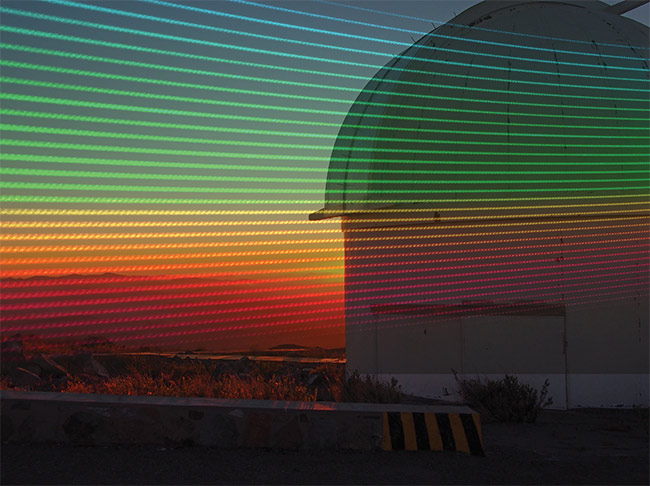
Supercontinuum-generated astrocombs routinely calibrate high-resolution astronomical instrumentation, such as the exoplanet hunter HARPS (High Accuracy Radial Velocity Planet Searcher) at the European Space Agency’s La Silla 3.6-m telescope.
Courtesy of Menlo Systems.
Not only could traditional broadband sources eventually be usurped by supercontinuum lasers in applications such as spectroscopy, but with novel architectures and hand-held versions on the horizon, new applications for these lasers abound.
SCG is an extraordinarily complex endeavor that leverages a highly intricate optical architecture to achieve nonlinear
processes that are efficient only in high-peak-power regimes, and it packages everything into a highly reliable tool.
Choosing a pump laser that delivers the right set of performance parameters can help simplify multiple features of supercontinuum laser design, including the oscillator, the mode of operation, the pulse width, the central wavelength, and the peak power, said Vincent Tombelaine, CTO of supercontinuum laser manufacturer LEUKOS.
Generally speaking, SCG seeks to efficiently exploit nonlinear optical processes to convert pulsed laser light into a broader wavelength range.
A key way to produce a low-noise supercontinuum source is to utilize a femtosecond pulsed laser as the seed or pump. The dependence on high peak powers
usually requires highly confined femto-
second pulses carrying hundreds of picojoules to tens of nanojoules to keep diffractive effects at a minimum. In most commercial instruments, this is carried out by using either nonlinear crystals or nonlinear fibers. The latter option usually employs photonic crystal fiber with low anomalous dispersion and high confinement.
The major barrier to entry for new commercial players lies in the complexity
of this process. It requires a heavy capital investment and navigation of the current intellectual property environment to design and manufacture large volumes of photonic crystal fiber, while maintaining quality and repeatability across the product batches.
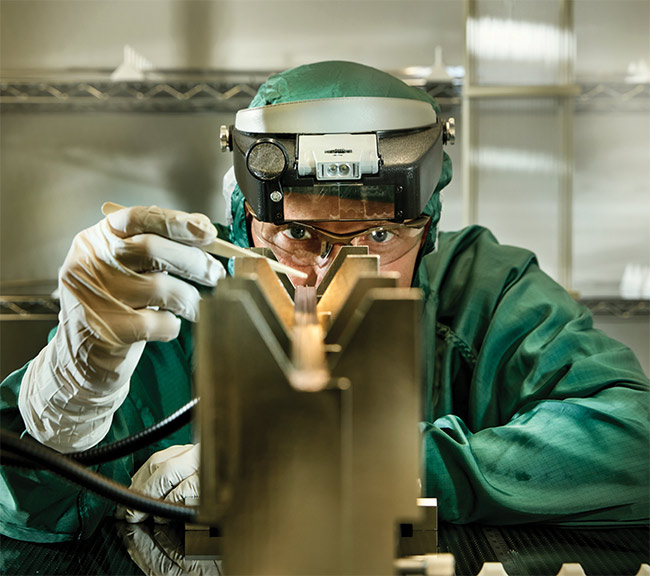
A key way to produce a low-noise supercontinuum source is to use a femtosecond pulsed laser as the seed or pump. Supercontinuum generation relies on highly confined high-energy femtosecond pulses. Many commercial instruments, in turn, rely on photonic crystal fiber to deliver both low anomalous dispersion and high confinement. Courtesy of NKT Photonics.
“This is a constant challenge for any manufacturer venturing into this field, and not many have done it in a sustainable and scalable fashion with documented results,” said Deepak Nair, product line specialist for supercontinuum lasers at NKT Photonics. “This is not a trivial path, even for large players in the field of lasers and optics.”
One such supercontinuum stalwart is Thorlabs, which leveraged recent advancements in drawing fluoride glass into optical fibers to achieve femtosecond supercontinuum generation in the mid-infrared.

The complexity of supercontinuum generation, combined with the need to reliably fabricate photonic crystal fiber in large volumes, presents two major barriers to entry for new commercial players wishing to provide these sources. Courtesy of NKT Photonics.
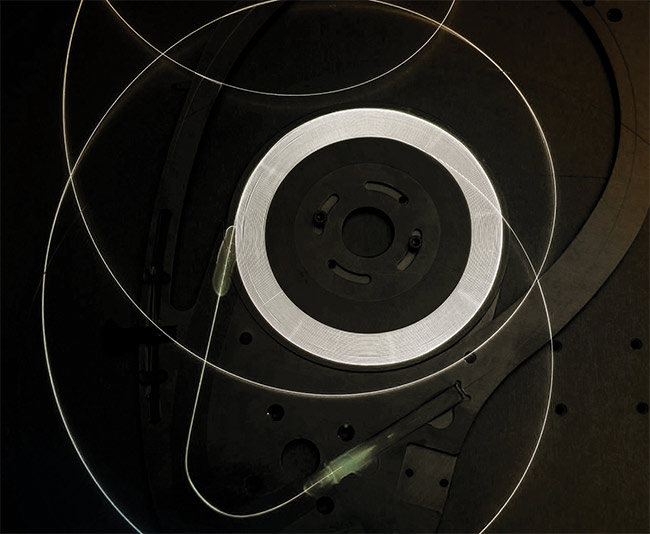
Supercontinuum generation in a polymer crystal fiber. Courtesy of NKT Photonics.
The fibers are drawn with tight control over their geometry, allowing them to produce the dispersion profile needed for efficient spectral broadening.
“Developing a femtosecond supercontinuum architecture is challenging, as it requires a stable mode-locked laser system as well as a carefully designed nonlinear fiber with favorable dispersion
properties for femtosecond spectral broadening,” said Reza Salem, fiber laser program manager at Thorlabs.
Spectroscopy: an emerging market
SCG is particularly challenging in the mid-infrared region, where the choice of femtosecond lasers and nonlinear fibers is limited. But given the mid-infrared’s value to spectroscopy, supercontinuum lasers could provide a particularly valuable tool compared to traditional light sources.
“Supercontinuum light offers broadband radiation, very much like what is available from incoherent sources such as light bulbs and globars, but with the key advantage of offering a laser-like beam with spatial coherence,” Salem said. “Such a property makes these sources useful in applications where the overall brightness of the beam and its mode quality are important.”
The high cost of supercontinuum sources has meant that the lasers are used only for applications in which they provide a significant performance advantage. However, Salem said Thorlab’s mid-infrared sources with coverage spanning 1.3 to 4.5 µm are being adopted for applications in near-field microscopy and open-path analyzers.
Similarly, applications such as hyperspectral cameras and infrared microscopy that employ broadband light sources to achieve high-resolution imaging can also benefit from these lasers. There is also interest in pushing supercontinuum
generation beyond the mid-IR and into
the so-called fingerprint region, where molecules exhibit unique spectral signatures.
“Supercontinuum sources covering this region with high-quality beams will allow for fast, remote detection of compounds,” Salem said.
Optical frequency combs
Beyond its direct applications in spectroscopy, SCG is also a driver for other photonic technologies, such as optical frequency combs. A frequency comb relies on an ultrastable train of femtosecond laser pulses and can be thought of as a light source delivering a spectrum of equidistant and ultranarrow spectral lines.
Menlo Systems, the first commercial supplier of optical frequency combs, employed fiber-based SCG to generate its frequency combs across an ever increasing wavelength range. The company combines its femtosecond fiber laser technology with SCG to preserve the comb structure of the fiber laser output while transferring it to ultrabroadband wavelength ranges in the visible or the mid-IR. This can be achieved without any sacrifice to comb performance, a phenomenon known as spectral purity transfer.
“This requires robust and reliable femtosecond laser light sources operating with ultralow phase noise, and results in SCG-based frequency combs serving a broad variety of applications, ranging
from high-precision metrology and space-compatible technologies to high-resolution spectroscopies, optical clocks, and quantum computing,” said Jaroslaw Sperling, business developer at Menlo Systems.
Hunting for Earth-like planets
A peculiar application of SCG-based frequency combs outside the laboratory is the calibration of spectrographs at astronomical observatories. These spectrographs need continuous calibration
because their long-term accuracy is
critical for detecting Earth-like extrasolar planets via radial-velocity measurements.
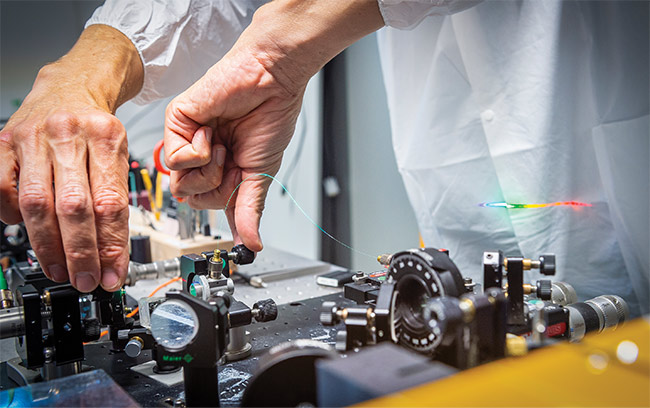
A key challenge for supercontinuum generation is achieving good spectral stability of the source’s supercontinuum spectrum and long-term stability of the photonic crystal fiber. Courtesy of Menlo Systems.
“By calibrating the spectrograph
with a SCG-based frequency comb, the velocity of distant stars can be determined down to 2.5 cm/s through the
Doppler shift of the star’s spectrum,” Sperling said. “Beyond these so-called astrocombs, the latest advances in fiber-based SCG have allowed us to generate SCG-based frequency combs that are spectrally flat and sufficiently powerful across an unprecedentedly wide wavelength range.”
In practical terms, such frequency combs allow up to seven continuous-wave lasers to be frequency-locked to a single supercontinuum source, which keeps both complexity and costs down. Such systems are ideal for comparing optical clocks operating at different wavelengths, or for simultaneous manipulation of the electronic transitions of different atomic species in quantum computing.
Hand-held supercontinuum lasers
Superlight Photonics, a spin-off from the University Twente in Enschede, Netherlands, recently demonstrated so-called dispersion-patterned waveguides that are able to drastically reduce the pump laser power required for SCG. These waveguides iteratively alternate between normal and anomalous dispersion modes to enhance pump power efficiency by up to a factor of 1000 compared to conventional technology.
When combined with ultracompact pump lasers, the concept could pave the way to portable hand-held sensing devices.
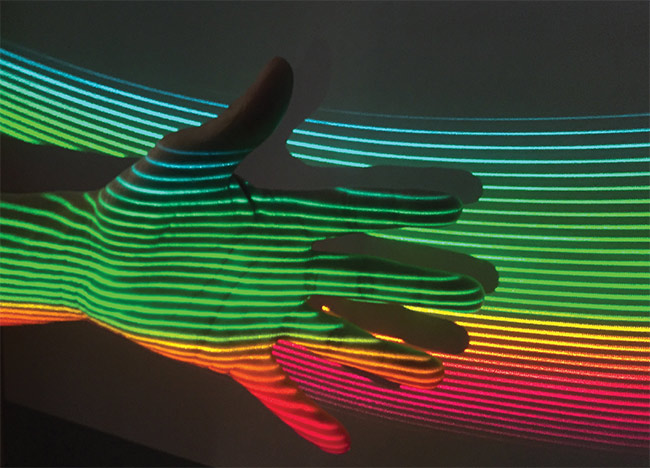
In so-called astrocombs, supercontinuum generation is used to create optical frequency combs with a flat spectrum and large mode spacing. Astrocombs are effective tools in the calibration of the spectral resolution and spectral coverage of astronomical spectrographs. Courtesy of Menlo Systems.
Previously, SCG could be categorized into two broad domains, distinguished
by the waveguide material’s dispersion, said Haider Zia, founder of Superlight Photonics. In normal dispersion waveguides, where the dispersion coefficient is negative, the natural tendency is for “bluer” frequencies to be delayed and “redder” frequencies to be faster than
the pump laser pulse’s central frequency, he said.
This effect combines with the generation of frequencies in SCG to accelerate the dispersive broadening of the pulse in time. Therefore, in normal dispersion SCG, the pulse quickly loses its peak power and any further bandwidth generation ceases. However limited in bandwidth, the spectra produced are smooth, without many modulations across them.
“In anomalous dispersion waveguides, the bluer frequencies are faster, while the redder frequencies are slower — the exact opposite case to normal dispersion, and the dispersion coefficient is positive,” Zia said. “The dispersion in this case works to bring together the generated frequencies such that the pulse temporally compresses, raising its peak power and accelerating bandwidth generation.”
This only continues to a certain point. What happens next is that the pulse shapes itself into a stable configuration called a soliton, in which the nonlinear generation and dispersion work in opposition until no new spectral generation can take place. Anomalous dispersion SCG usually generates larger bandwidths than normal dispersion SCG, but its spectrum is more modulated.
In both anomalous and normal dispersion SCG, spectral broadening stops after a certain propagation length in the waveguide. By alternating between anomalous and normal waveguide dispersion, the stagnation mechanism in either type is overcome. This increases the length of propagation where spectral generation
can occur, which massively reduces the powers required to generate it.
More specifically, Superlight Photonics’ approach has shown that the pulse energy needed for wide-bandwidth SCG at a 1/e beam diameter has significantly dropped to around 1 to 3 pJ, which is available from state-of-the-art integrated ultrafast diode lasers centered at 1550 nm1. Spectral power is also more balanced across the generated bandwidth, which is integral for high-quality OCT devices or laser spectrometers, or for pulse compression.
Superlight Photonics’ approach potentially replaces pump lasers that would have once spanned meters with sources that can now fit in the palm of the hand. “This means that truly integrated large-bandwidth lasers are on the horizon,” Zia said. “The portable laser source market would massively and directly benefit from this disruptive technology.”
Superlight Photonics intends to offer SCG chips capable of using Menlo Systems’ ultracompact line of low-power femtosecond fiber lasers. “Instead of having the bulky laser that you see on self-driving cars for lidar, for example, you can have integrated chips in, say, the car headlamps, for a more aesthetic look,” Zia said.
LEUKOS has its own plans for shrinking supercontinuum sources, according to Tombelaine. Volumes of about 250 cm3 for ultracompact lasers are now being reached, he said.
“Expertise in the supercontinuum pump laser design and the coupling method in the nonlinear medium is
essential to miniaturize the supercontinuum laser,” Zia said. “The two most significant recent trends we’ve noticed are supercontinuum miniaturization for hand-held and embedded equipment, and the extension of supercontinuum spectral coverage up to the 10-µm wavelength range.”
Driving future growth
Tombelaine stressed the importance of research and innovation in remaining competitive, as well as the importance of customer-oriented development of supercontinuum lasers and accessories.
The cost to manufacture supercontinuum lasers remains higher than that for a broadband lamp or other incoherent light source, he said. “Also, the supercontinuum laser often delivers Class 4 laser radiation, so it requires special awareness and safety precautions.”
NKT Photonics’ Nair believes that staying innovative is critical to staying in business. To keep up with trends in the markets most benefiting from supercontinuum technology, the company must offer systems with more output power, larger spectral bandwidths, and longer lifetimes, he said.
“We invest heavily in the reliability studies of our lasers. At any time, we have close to 100 supercontinuum lasers running 24/7 in our reliability program collecting data, which aids in the constant improvements we make to the performance of our lasers,” Nair said. “In most cases, the adaptation of a supercontinuum light source in an industrial application is a part of a paradigm shift. We must focus on and improve the light delivery interfaces and the light conditioning architecture, such as spectral filtering, wavelength tuning, fiber delivery, and so on.”
The future of supercontinuum generation will no doubt bring further improvements to technical specifications such as noise and brightness. And by reducing the cost of these lasers, more applications can capitalize on their broadband and beam-like emission.
These technological advancements could gain further momentum due to legislative pressures against traditional broadband light sources such as halogen lamps, which leads supercontinuum laser suppliers to conclude that the technology has an exceptionally bright future.
Reference
1. H. Zia et al. (January 2023). Ultraefficient on-chip supercontinuum generation from sign-alternating-dispersion waveguides. Adv Photonics, www.doi.org/10.1002/adpr.202200296.